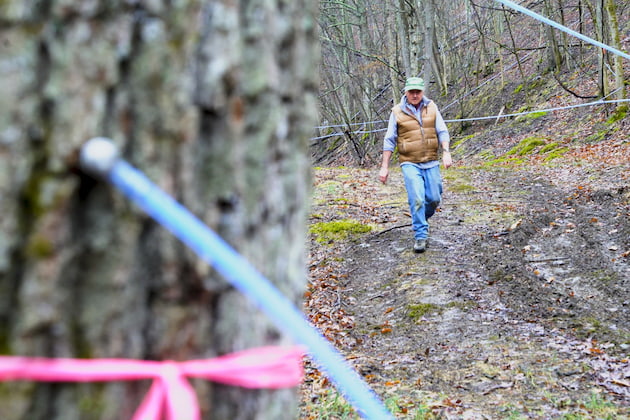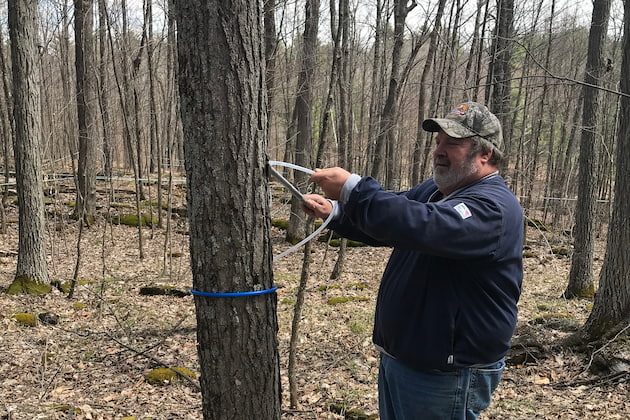Season Summaries
Cleanup. The season is not over when the sap stops running
Experts offer tips on end-of-season shutdown
By PAUL POST | APRIL 12, 2023
RUPERT, Vt.—For many, the sap has stopped. Before putting a sugarbush to bed, critical steps should be taken.
"It's not enough to remove taps and move on," said maple specialist Mike Rechlin of Future Generations University in Franklin, W.V.
"You've got to get the gunk out. You don't want to leave it there. You want to clean it, but you want to do more than that. Cleaning is one thing, sanitizing is a completely different thing."
Cleaning alone doesn't rid lines of fungi, yeast and bacteria that can build up and ruin sap and syrup next season, if left untreated.
"Sap lines are porous material. Fungi, yeast and bacteria become imbedded in the porosity of that material, deep down in the line structure," Rechlin said during a recent talk, "The End of Year Clean, Sanitation 101.
"We want to kill the bacteria not only on the surface, but deeply imbedded in structure of that material. Spores and fungus can stay active and alive for two or more years. If they haven't been killed in your sap line, then it's there to cause problems before you ever tap a tree next season."
"So it's important to clean and sanitize so you aren't starting next year's race behind the start line," he said.
Rechlin referenced decade-long research by Cornell University and the University of Vermont highlighting the significant financial rewards that can be achieved by adhering to sound spout and tubing sanitation practices.
Installing new spouts, then cleaning lines and sanitizing them with bleach solution after each season, resulted in a 75 percent higher sap yield.
Kate Fotos, also of FGU, briefly noted four different ways to clean lines prior to sanitizing. They are:
* Back-flush with distilled, well or spring water to remove blockages.
* Leave sap in lines from the last run, which turns to vinegar over the summer, and drain onto the ground in autumn.
* Dry Vac: Pull a tap and let air get sucked through. While pulling taps, air dries out the line so sap doesn't sit and turn sour in summer.
* Hang and dry: Pull and let taps hang and dry for one or two weeks; then come back and cap them. But leaving taps uncapped could lead to nuisance bug activity and this method doesn't remove blockages.
Citing work done by the late Arthur Krueger of Shrewsbury, Vt., Rechlin and Fotos suggested sanitizing lines with a calcium hypochlorite bleach solution off 400 parts per million. A product called Zappit is one option.
Calcium bleach should be used instead of standard household sodium bleach because sodium degrades into sodium chloride (salt), which attracts squirrels that chew and destroy lines.
Calcium degrades into lime, whose bitter taste repels squirrels, while still providing the same sanitizing benefits as sodium bleach.
"Arthur did this for seven years and contended that his lines ran as well as the first year he put them in, just like new," Rechlin said.
Fotos outlined several different sanitizing techniques.
"There are a lot of ways to get this sanitizing fluid into your lines," she said.
One method is using a backpack sprayer, which is good for reaching remote areas that vehicles can't get to. Squirt sanitizer into the drop line and cap it off.
But if it's possible to reach the top end of a line by truck, put a tank on it and gravity-feed solution down the mainline.
Another way, with a diaphragm pump, is to flip it around and reverse-pump solution back up the lines. A gas-fired auxiliary pump is more powerful than a diaphragm pump and gets solution further up lines.
Or, it's possible to carry solution and with a vac pump running, pop the tap out of the tree, stick it into a cup of solution and let the pump suck solution down the line.
"All of these have their pros and cons," Fotos said.
Fluid must remain in lines for 30 minutes to be fully effective. If it's simply running through it will kill some, but not all harmful bacteria. This can be prevented by clamping off the ends of lines.
One of the big questions, when sanitizing, is whether to start on the high end and work downhill, or vice versa?
"It's preferable to start at the high end to get through whole system," Fotos said. "If you start at the bottom you'll run into head pressure, which affects how far up you can pump fluid and how much gets sanitized. Some people pump from the bottom as far as they can and finish off with a backpack sprayer from the top. If starting from the bottom, make sure you're venting at top because you're going to be displacing air, which can create air lock, so fluid can't get past an air bubble in the system. The top tap should be uncapped to make sure air escapes."
If working from the top down, seal off the bottom, so fluid doesn't run out. "Once you start pumping down, go to each tap, follow liquid down the system to make sure it's coming out," Fotos said.
A small SteriCap device can be used that fits over taps and holds sanitizing solution around them so taps can be used over again.
"Not everybody sanitizes the same way," Fotos said. "Find a system that works for you. If you can do your whole system efficiently, that's the best option. If you can't do your whole system it's better to do some than none at all."
Rechlin urged listeners to pull taps and start sanitizing as soon as the season ends.
"We want to give the trees as much of the growing season as possible to heal that tap hole," he said. "The sooner it's sealed off the sooner the infection potential ends and you're no longer getting microbes into the tree."

































